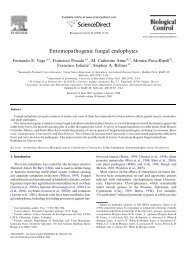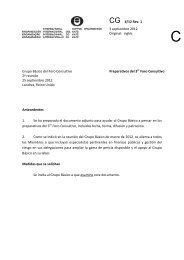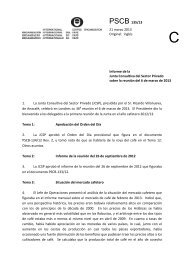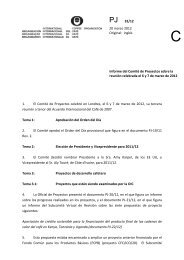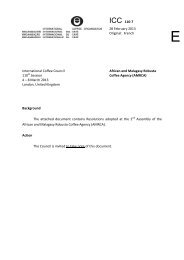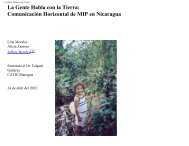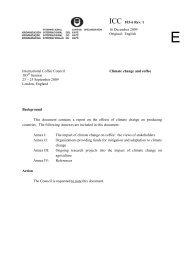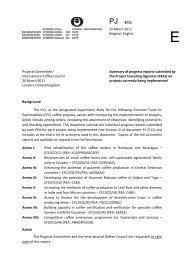Devouring profit - International Coffee Organization
Devouring profit - International Coffee Organization
Devouring profit - International Coffee Organization
Create successful ePaper yourself
Turn your PDF publications into a flip-book with our unique Google optimized e-Paper software.
4.4 Cost structure for<br />
CBB management<br />
In case studies carried out in Colombia (Duque et al., 2002), the cost of CBB management<br />
varied between 5.5% and 11.0% of the total production cost. Here it is important<br />
to clarify that a higher or lower percentage is related not only to the intensity of<br />
the pest management but also with the proportion of coffee in production or under<br />
new plantings. When there are extensive areas with young trees, CBB control costs<br />
less. On the other hand if coffee is not being renovated (the case with most smallholders),<br />
the effect of CBB and its costs of control become greater. A theoretical model of<br />
CBB cost management developed in Cenicafé (Duque, 2001), shows clearly that<br />
when the coffee plots are younger the management cost is lower than for older plots.<br />
In these latter plots the average cost was about 8.7% whilst the estimated national<br />
average is about 7%. 8.7% is an appreciable extra cost burden and shows why CBB<br />
management has become a key component of coffee production in Colombia. Of this<br />
CBB management cost, labour costs comprise 89% because of the high dependence<br />
on laborious cultural control.<br />
This high dependence on labour is a severe problem and has many ramifications:<br />
It has long been recognised that smallholders can produce better quality coffee<br />
than large farmers because they know their plots well, carry out timely controls<br />
and can pick the berries at the optimum moment to achieve peak quality.<br />
It is customarily believed that smallholder farmers have abundant family labour to<br />
accomplish these tasks.But results from this (Appendix A) and a previous study<br />
(Baker, 1999) suggest that this is not necessarily so; families are now not always<br />
so large and in some places farmers see more future for their family in keeping<br />
their children in school.<br />
Smallholder farmers may work on neighbouring large farms because of their need<br />
for ready cash.<br />
Larger farmers may tend to reduce labour costs by resorting to insecticides,<br />
sprayed by these same smallholders.<br />
Smallholders may therefore neglect their own farm, leading to higher pest levels<br />
and lower quality. In this case, migration of CBB from their untended plots spreads<br />
the problem.<br />
49




